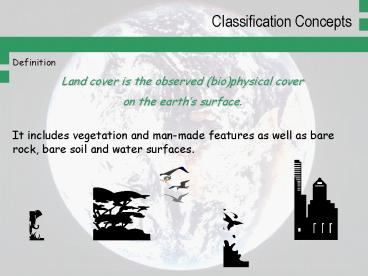Definition PowerPoint PPT Presentation
1 / 10
Title: Definition
1
Definition Land cover is the observed
(bio)physical cover on the earths surface. It
includes vegetation and man-made features as well
as bare rock, bare soil and water surfaces.
2
Difference between Classification and Legend
Legend is defined as the application
of a classification in a particular area (Di
Gregorio and Jansen, 1998).
3
Current a-priori classifications in relation to
flexibility
Class boundary definitions will be clear and
classes will contain aggregated land cover types.
By increasing the number of classes in an
a-priori system, the problem arises of how a
user will find its way.
Flexibility that will allow the accommodation of
any occurring land cover.
Class boundary definitions are based on very
slight differences
4
New approach to classification
-1- Increasing flexibility
while maintaining mapability The classification
should be flexible in the sense that it should
address the potential for the classification
system to describe enough classes to cope with
the real world. At the same time flexibility
should adhere to strict class boundary
definitions that are unambiguous and
clear. Basic principle A land cover class is
defined by the combination of a set of
independent diagnostic attributes, the so-called
classifiers that are arranged to assure a high
degree of mapability, i.e. geographical accuracy.
5
The initial Dichotomous Phase of LCCS
Below the Dichotomous Phase is shown consisting
of pairs of buttons of which the user can select
one at the time.
Classifier used Presence of Vegetation
Classifier used Edaphic Condition
Classifier used Artificiality of Cover
6
The subsequent Modular-Hierarchical Phase of LCCS
The sets of classifiers tailored to the major
land cover and hierarchically arranged according
to mapability (classifiers presented in dark
blue).
7
- Concept for creation of a land cover class
- Stepwise selection of classifiers that will
generate - a string of codes, the so-called Boolean Formula
- a Standard Class Name and
- a unique Numerical Code.
With each classifier option selected, the string
of codes grows, the class name changes and so
does the code.
8
Overview of the software application
9
How to add User-defined Attributes? Land cover
classes can be cloned in order to add specific
user-defined attributes to the standard class. A
user may want to further define a classifier
and/or attribute already used, or add a new
attribute. A standard set of clone options is
provided.
The user-defined code is specified in this window
as well as its meaning.
The Type of Clone to be made is selected in this
window. The result is a code added to the Boolean
code (e.g. (1) in the example above)
10
A priori versus a posteriori classification
Example of a very general a priori classification
based on four classes (triangle in black and
white and circle in black and white) representing
the field situation below. Due to the
generalization of the classes, the user is
obliged to make the best fit of one of the
hundred possibilities in the field into one of
the four classes, which may result in selecting a
class that does not represent well the actual
situation.
Example of a posteriori classification. The
classes fit better the actual situation in the
field situation but the area described is only a
portion of the total.

